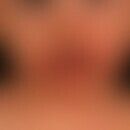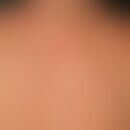Synonym(s)
HistoryThis section has been translated automatically.
Linnaeus, 1758
DefinitionThis section has been translated automatically.
Clothes lice (Pediculus humanus humanus) are insects from the order animal lice (Phthiraptera), the family human lice (Pediculidae), the species human lice (Pediculus humanus). The clothes louse is a human ectoparasite and prefers to colonize the body hair. It occurs in orderly social conditions. Epidemics occur in times of war and misery, often accompanied by head lice and crabs.
You might also be interested in
General informationThis section has been translated automatically.
Clothes lice are particularly well adapted to humans. The louse is not able to produce vitamin B5, which is essential for them, on its own. It is dependent on the metabolic activity of a bacterium (Candidatus Riesia) which lives symbiontically in the clothes louse. Furthermore, clothes lice are very insensitive and can survive up to 4 days without food at 25 °C.
Clinical pictureThis section has been translated automatically.
Both the capillitium and all other body hair is affected. Furthermore, it is found in the seams of clothes, where the nits are stuck in rows. From the hairs the louse moves to adjacent free skin areas. Here it pierces the skin to suck blood. The clothes lice on the capillitium infest auricles, forehead, neck and cheeks, recognizable by the red, urticarial, itchy stings. The louse is transmitted through physical contact, shared bedding or clothing. Under poor hygienic conditions, the clothes louse can transmit the following diseases:
- bacterial typhus (typhus, lice fever)
- the recurrentbacterial lice fever
- the tularaemia
- the Wolhynia fever.
It is not transmitted via the actual sting, but by contact infection or smear infection with the excrements of the lice.
Note(s)This section has been translated automatically.
In Germany, infestation with clothes lice must be reported to the public health department in accordance with the Infection Protection Act.
LiteratureThis section has been translated automatically.
- Coulaud PJ et al (2015) Hemocytes from Pediculus humanus humanus are hosts for human bacterial pathogens. Front Cell Infect Microbiol 4:183.
- Powers J et al. (2019) Pediculosis Corporis. In: StatPearls Publishing May 21.




